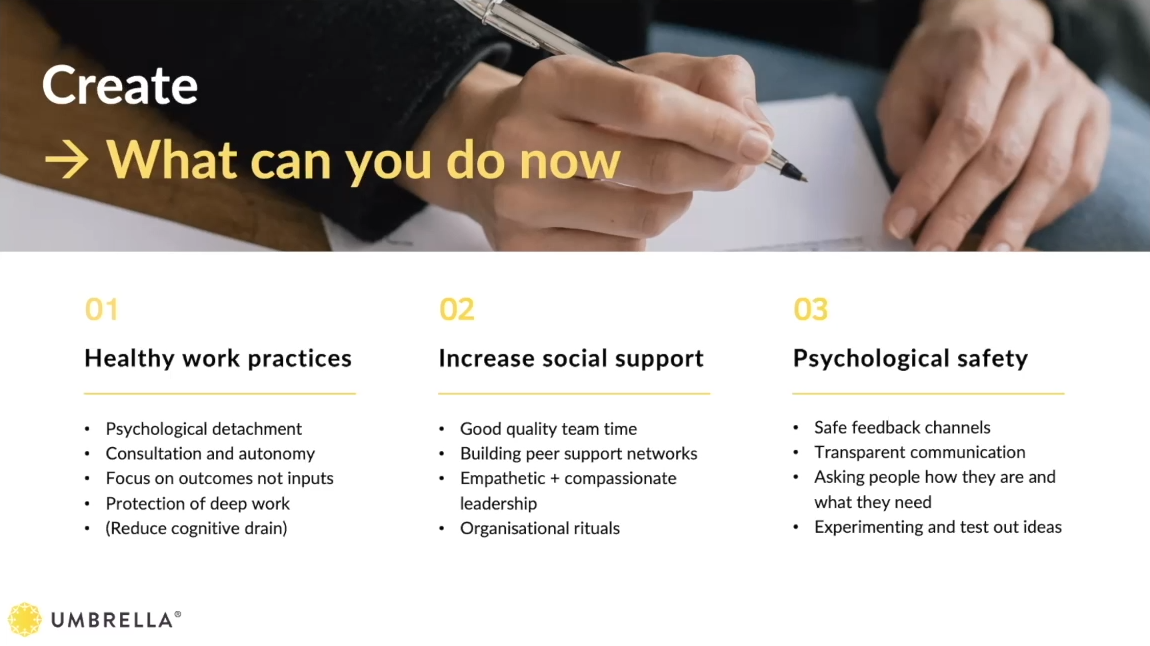Supporting wellbeing as a leader: 5 key takeaways
Following the release of our whitepaper in partnership with Umbrella Wellbeing, Gaynor Parkin, Clinical Psychologist and CEO of Umbrella Wellbeing, and Angela Vale, Motivational Life Coach and former CEO of Footprint, hosted a webinar to provide practical and research-based guidance about the best approaches business leaders can take to support the wellbeing of their people as well as their own. Here are the 5 key takeaways.
Research shows work demands have gone up
Based on international research, the common trait among both remote and front line workers showed that people are working longer hours and are finding it harder to switch off. Remote workers in particular reported feeling greater isolation and reduced communication and quality of communication among staff and leaders. Data from the Umbrella Wellbeing Assessment showed similar outcomes “in those early stages of COVID people were unseasoned, employees were uncertain and leaders did a great job of responding with clear plans, good communications, and lots of wraparound care” says Parkin. “Then we have the kind of vaccine mandates and more lockdowns and some of their optimism definitely dipped”.
*Front line workers include those continuing to be office based or onsite.
2. What employees want from their leaders
Parkin says “people are asking for more flexibility around how and when they work, more agency over what they're doing and when they're doing it . . . people want their work demands to be manageable.” More people are choosing the quality of life over everything, and in the age of the Great Resignation there are more options to choose where to work. Parkin explains that while the research does show common trends among employees, leaders need to do their research and assess what specifically it is that their staff need.
3. Adapting to the environment is key
Typically in the workforce “we oscillate between periods of challenge and stress then periods of recovery” says Parkin however with the challenge of COVID over the last couple of years, people are feeling more of a cumulative level of stress and less time for recovery. Vale advises that as a leader developing your Adaptability Quotient (AQ) is key to help navigate the constant change and challenges that arise. Footprint provides these tools through a life coaching psychology-based framework called ADAPT™ which helps leaders and employees set and achieve goals by addressing the belief system. Beliefs are what drive our thoughts, feelings, decisions and ultimately our behaviour, therefore to achieve desired outcomes we must start at the root.
4. Financial wellbeing impacts business productivity
Fifty percent of our workforce is stressed or concerned about money and adding to the rising cost of living, these numbers can expect to rise. Vale explains that “finances enable some of our most primitive needs . . . and as human beings if we feel that there's a threat, even subconsciously to what we consider our most basic needs, we can enter a fear state”. When employees feel more in control of their financial situation they are likely to get better results. On the contrary, when financial wellbeing needs aren’t met, we may begin to exhibit health concerns that lead to absenteeism, presenteeims and reduced overall productivity. These factors then contribute to impacts in the business.
5. What leaders can do to best support staff wellbeing
Parkin and Vale both agreed that leaders have a tough gig; they’re expected to do and be everything to everyone. Umbrella data showed that leaders are facing similar challenges as employees, reporting greater work demands, poorer work-life balance and less support from peers. Therefore in order to be there for your team you must make the time and space for yourself, only then can you provide appropriate support within your team.
Then ask your people what they need; do the research and be strategic in your approach. There’s no sense in addressing problems that don’t exist. Every organisation is different, and assessing the environment means looking at the full picture. Once you can identify the areas of focus Parkin suggests that you don’t need to address them all at once “pick one or two to focus on, make them better and then pick another one or two”.
Resources:
Umbrella’s Downloadable resources on wellbeing, mental health and promoting those in organisations
The White Paper: ‘Getting Under the Hood of Employee Financial Wellbeing' by Footprint Connect x Umbrella
For more financial wellbeing resources, news and updates subscribe to our newsletter





